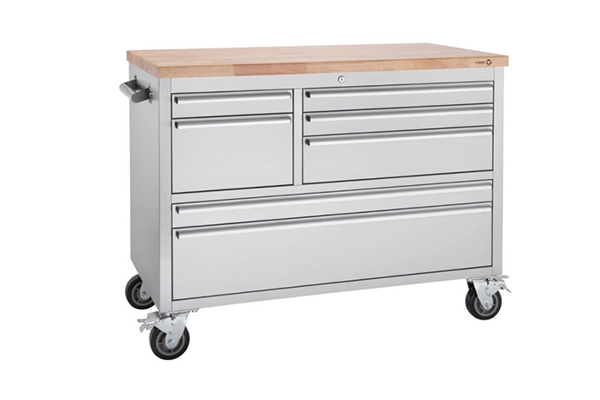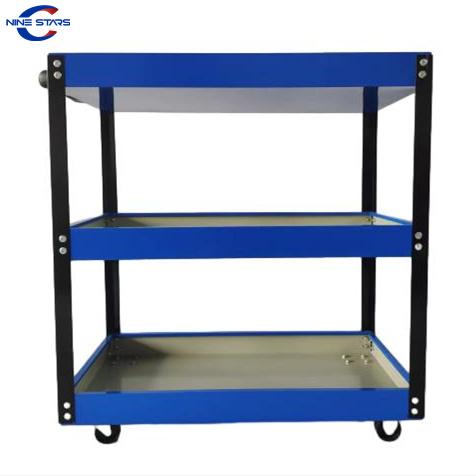This article provides a comprehensive guide to stainless steel tool chests, focusing on key features, benefits, and considerations for buyers like Mark Thompson, a 54-year-old company owner and procurement officer in the USA. We'll delve into why this article is worth reading: It directly addresses the needs and pain points of procurement officers in the tool storage industry, offering insights into choosing the right products from reliable suppliers, ultimately saving time and maximizing profit. We'll explore the perspective of someone like myself, Allen, a factory owner in China with 7 production lines, exporting to countries like the USA.
1. What Makes Stainless Steel Tool Chests a Superior Choice?
Stainless steel tool chests are a premium option for tool storage, offering several advantages over other materials like regular steel or plastic. Their inherent durability and resistance to rust and corrosion make them ideal for demanding environments, such as automotive workshops and construction sites. These products characteristics, are very important to Mark and people with similar profiles.
From my experience, the most common stainless steel grades used are 430 and 304. Grade 304 offers better corrosion resistance, especially in humid or coastal areas, making it worth the slightly higher price. For buyers like Mark, who prioritize longevity and quality, a 304 stainless steel tool chest is a worthwhile investment.
Think of it this way, you may buy a cheaper product, but need to buy another in 2 years. With 304 stainless, it might last 5-10.
2. What Are the Key Features to Look for in a Stainless Steel Tool Box?
When selecting a stainless steel tool box, several key features should be considered. These features directly impact the functionality, durability, and security of the box.
- Drawer Slides: Look for ball-bearing drawer slides for smooth and effortless operation, even when the drawers are fully loaded. Heavy-duty slides are crucial for withstanding the weight of numerous tools.
- Locking System: A secure locking system is essential to protect valuable tools from theft. Consider options like tubular locks or internal locking mechanisms for added security. A solid lock is always important!
- Handles: Sturdy and comfortable handles are crucial for easy portability, especially for larger tool boxes. Side handles and a top handle provide different carrying options.

For example, our Folding Tool Box 3 Layer Tool Box Accordion Tool Box Portable Tool Box features a robust design with multiple compartments. This aligns with the needs of professionals who need organized and easily accessible tool storage.
3. How Do Tool Trolleys Enhance Productivity and Organization?
Tool trolleys, also known as rolling tool carts, are designed to improve workflow efficiency by keeping tools within easy reach. They are particularly useful in large workshops or garages where mobility is essential.
The mobility offered by a tool trolley significantly reduces the time spent retrieving tools, leading to increased productivity. Features like multiple drawers, trays, and shelves provide ample space for organized tool storage. The sturdy construction and heavy-duty casters ensure that the cart can handle the weight of a substantial tool collection. We often see productivity increases of at least 15% by simply having a mobile workstation.
4. Why are Tool Cabinets Essential for Secure Tool Storage?
Tool cabinets offer the highest level of security for valuable tool collections. They are typically larger than tool boxes and tool chests, providing substantial storage capacity.
Tool cabinets often feature locking doors and drawers, providing a secure environment for storing expensive power tools and specialized equipment. They are a crucial investment for businesses that need to protect their assets from theft or damage. Many tool cabinets also come with adjustable shelves, allowing for customization based on the size and type of tools being stored.
5. How to Choose the Right Size and Type of Tool Chest?
Choosing the right size and type of tool chest depends on the specific needs of the user and the volume of tools they need to store.
Consider the following factors:
- Number and Size of Tools: A larger collection of tools will naturally require a larger tool chest or tool cabinet.
- Workspace: The available space in the workshop or garage will also dictate the size of the tool storage solution.
- Portability: If tools need to be transported frequently, a portable tool box or a rolling tool chest is a better option than a stationary tool cabinet.
For instance, a mechanic working in a large automotive workshop might benefit from a 72-inch rolling tool chest with multiple drawers and a large top chest. On the other hand, a DIY enthusiast with a smaller tool collection might find a 30-inch tool chest or a portable tool box sufficient.
6. What's the Difference Between a Tool Box and a Tool Chest?
While both tool boxes and tool chests serve the purpose of tool storage, there are key differences between them.
- Tool Box: Typically smaller and more portable, designed for carrying a limited number of tools. They often have a single compartment or a few removable trays.
- Tool Chest: Larger and designed for stationary use or rolling, offering more storage capacity with multiple drawers.
Think of a tool box as a lunchbox for your tools, while a tool chest is more like a refrigerator.
7. What Certifications Should I Check When Buying Tool Storage Products?
When purchasing tool storage products, especially from international suppliers, verifying relevant certifications is crucial for ensuring quality and safety. As a factory owner, I understand Mark's concern about certificate fraud.
Look for certifications such as:
- ISO 9001: This certification demonstrates that the manufacturer has a quality management system in place.
- CE Marking: This marking indicates that the product complies with European safety, health, and environmental protection requirements. Relevant for exports to Europe.
- ANSI Standards: Various ANSI standards apply to specific tool types and storage solutions, ensuring they meet safety and performance requirements in the USA.
Always request copies of the certificates and, if possible, verify their authenticity with the issuing body. This diligence protects your business from potential liabilities and ensures you receive high-quality products.
8. How Can I Ensure Efficient Communication with Suppliers?
One of Mark's pain points is inefficient communication with supplier sales representatives. This is a common challenge in international trade, but it can be overcome with proactive measures.
Here are some tips:
- Use Clear and Concise Language: Avoid jargon and technical terms that may be difficult for non-native English speakers to understand.
- Utilize Visual Aids: Pictures, diagrams, and videos can be very helpful in clarifying requirements and avoiding misunderstandings.
- Establish Regular Communication Channels: Set up regular video calls or email updates to maintain open communication and address any issues promptly.
- Use Translation Tools When Necessary: While not perfect, translation tools can help bridge the language barrier.
As Allen, I ensure my sales team is trained to communicate effectively with international clients, understanding their specific needs and addressing their concerns promptly. We prioritize clear and consistent communication throughout the entire process, from initial inquiry to after-sales service.
9. What Are the Best Payment Methods and Logistics Options for International Trade?
Navigating payment methods and logistics is crucial for successful international trade. There are risks and advantages to each system.
Common payment methods include:
- Letter of Credit (LC): A secure payment method where the buyer's bank guarantees payment to the seller upon presentation of specified documents. This offers protection for both parties.
- Telegraphic Transfer (TT): A direct bank transfer, which is faster but carries a higher risk for the buyer if the supplier is unreliable.
- PayPal: A convenient option for smaller transactions, but fees can be high for larger amounts.
Logistics options include:
- Sea Freight: The most cost-effective option for large shipments, but transit times are longer.
- Air Freight: Faster but more expensive, suitable for urgent or smaller shipments.
- Courier Services: The fastest but most expensive option, typically used for samples or small, high-value items.
Working with a reputable freight forwarder can simplify the logistics process and ensure timely delivery. Always obtain shipping insurance to protect against potential loss or damage during transit. Our 1/2 Impact Socket Drive Metric Impact Socket Set Car Repair Tools are carefully packaged to ensure safe arrival, minimizing risks during transit.
10. Where Can I Buy High-Quality Tool Storage Solutions at Competitive Prices?
Finding a reliable supplier that offers both high quality and competitive prices is key to Mark's profit model.
Consider the following sources:
- Direct from Manufacturers (like my company): Buying directly from factories in countries like China can offer significant price advantages. This is our B2B business model.
- Exhibitions: Attending industry trade shows allows you to meet potential suppliers, see their products firsthand, and negotiate prices. This is a primary promotion channel for us.
- Online Marketplaces (Caution): While online platforms like Amazon and Alibaba can provide access to a wide range of suppliers, it's crucial to exercise caution and thoroughly vet potential suppliers to avoid scams or low-quality products.
Remember to prioritize quality and reliability over the lowest possible price. A slightly higher upfront investment in a durable and well-made tool storage solution will pay off in the long run. A good tool chest, or a simple Ratchet Wrench Auto Repair Ratchet Wrench Quick Ratchet Wrench can save you time and money.

Key Takeaways:
- Stainless steel tool chests offer superior durability and corrosion resistance, making them a worthwhile investment for professionals.
- Key features to consider include drawer slides, locking systems, and handles.
- Tool trolleys enhance productivity by keeping tools organized and mobile.
- Tool cabinets provide maximum security for valuable tool collections.
- Choosing the right size and type of tool storage depends on individual needs and workspace.
- Verify certifications to ensure product quality and safety.
- Establish clear communication channels with suppliers.
- Choose appropriate payment methods and logistics options for international trade.
- Source products directly from manufacturers or through reputable channels.
- Our 32 Pcs Tool Kit Silver-Colored Wrench Socket Set Auto Repair Machine Repair Ratchet Wrench Socket offers a cost-effective solution for auto repair.
- Always balance price and quality for long-term value, remember a tough, quality product will save you in the end.
Post time: 03-18-2025



